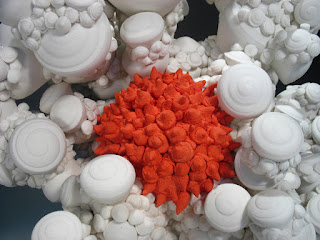In class we discussed Jeanne Robert
Foster’s position upon returning to the Adirondacks: an outsider in a place of
outsiders, entering a familiar but distant world on the periphery. Foster
observed and wrote about the ordinary community life of those in Adirondacks through
a lens filtered by her city perspective. This city versus rural and industrial
versus natural dichotomy is one that greatly affects my own gaze as navigate
through this place of the Adirondacks. While in most moments the tension
between these two spaces feels stark and entirely oppositional, recently
stumbling upon the sculptures of Patsy Cox has redefined the ways in which I’ve
come to understand and experience the city and the Adirondacks.
In her exhibit Romanesco Fractals, Patsy Cox, taking inspiration from the
logarithmic buds of the Romanesco
Broccoli, uses the fractal spirals found in nature to create urban
city-like clusters. Only when inspected closely can one see the intricate
repetitive forms of Cox’s pieces; the viewer is perhaps, at times, overwhelmed by the
busyness of repetition, something that Cox, in her description of the piece,
describes as a celebration of the “structure, activity and growth found both in
nature and the urban landscape… The conceptual combination of the manmade
metropolis with the clumping, sprouting, flowering structures of natural plant
life provides a point of intersection.” Her use of saturated and vibrant primary colors alongside
stark whites seems dichotomous to the organic and fluid forms of the fractals; the colorful portions are contrastive not only through hue, but also in shape:
though maintaining the repetitive fractal pattern, the pointed spiraling cones
seem to be reminiscent of divergent growths, nesting upon the soft white
spirals. Perhaps Cox in this way, aimed to explore the complex relationship between the
natural and the artificially manufactured, between the busyness of nature and
the repetition of the world of mass production and consumerism. Her
pieces thus seem to examine both the fundamental similarities and differences of
natural versus industrialized places. This exploration seems especially relevant to the place of the Adirondacks, where within the blue line there are spaces of wilderness alongside industrialized areas, both luring tourists to the park in seemingly contrastive ways. Perhaps, as explored through Cox's pieces, these places possess more similarities than I previously thought.



Love this! You (and Patsy Cox) are natural deconstructionists, taking apart seemingly stable and clear binaries.
ReplyDelete